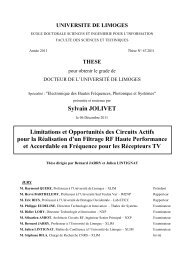Extraction, caractérisation chimique et valorisation biologique de ...
Extraction, caractérisation chimique et valorisation biologique de ...
Extraction, caractérisation chimique et valorisation biologique de ...
You also want an ePaper? Increase the reach of your titles
YUMPU automatically turns print PDFs into web optimized ePapers that Google loves.
Figure 59 : Catalyseurs utilisés pour l’oxydation ................................................................... 100<br />
Figure 60 : Principe du système utilisé .................................................................................. 100<br />
Figure 61 : Synthèse <strong>de</strong> phtalocyanines sans solvant ............................................................. 101<br />
Figure 62: Synthèses <strong>de</strong>s porphyrines .................................................................................... 102<br />
Figure 63 : Protocole d’extraction <strong>et</strong> <strong>de</strong> <strong>caractérisation</strong> <strong>de</strong>s xylanes <strong>de</strong> châtaignier .............. 103<br />
Figure 64: Principe <strong>de</strong> la délignification par les phtalocyanines <strong>et</strong> les porphyrines. ............. 104<br />
Figure 65 : Proposition <strong>de</strong> mécanisme pour le clivage <strong>de</strong> la liaison C2-C3 d’un anhydroglucose<br />
................................................................................................................................................ 106<br />
Figure 66 : Spectre RMN 1 H (D2O) du xylane extrait dans l’eau à partir d’un résidu<br />
holocellulosique délignifié par le système FePcS/H2O2. ....................................................... 109<br />
Figure 67 : Réaction <strong>de</strong> Cannizarro ........................................................................................ 113<br />
Figure 68 : Spectre RMN 1 H (D2O) du xylane <strong>de</strong> châtaignier natif avant <strong>et</strong> après oxydation<br />
par le système FePcS/H2O2. ................................................................................................... 114<br />
Figure 69 : Réaction d’équilibre d’un aldéhy<strong>de</strong> dans l’eau ................................................... 115<br />
Figure 70 : Spectre IR <strong>de</strong>s xylanes <strong>de</strong> hêtre <strong>et</strong> <strong>de</strong> châtaignier avant <strong>et</strong> après oxydation par le<br />
système FePcS/H2O2 .............................................................................................................. 115<br />
Figure 71 : Profils <strong>de</strong> masses <strong>de</strong> glucuronoxylanes <strong>de</strong> hêtre ayant ou non subi un traitement<br />
oxydatif par le système FePcS/H2O2 ...................................................................................... 116<br />
Figure 72: Présentation du système <strong>de</strong> photooxydation. ........................................................ 118<br />
Figure 73 : Filtrats correspondant aux délignifications photo<strong>chimique</strong>s. .............................. 120<br />
Figure 74 : Protocole d’extraction <strong>de</strong>s xylanes <strong>de</strong> châtaignier MGX C1 <strong>et</strong> MGX C2 ............ 132<br />
Figure 75 : Protocole d’extraction <strong>de</strong>s xylanes d’argan MGX A <strong>et</strong> HX ................................ 133<br />
Figure 76 : Degrés <strong>de</strong> polymérisation <strong>de</strong>s différents xylanes extraits .................................... 135<br />
Figure 77 : Superposition <strong>de</strong>s profils d’élution obtenus par analyse HPLC <strong>de</strong>s MGXs <strong>et</strong> du<br />
HX. . ...................................................................................................................................... 136<br />
Figure 78 : Distribution <strong>de</strong>s aci<strong>de</strong>s uroniques <strong>de</strong>s xylanes <strong>de</strong> châtaignier <strong>et</strong> d’argan après<br />
autohydrolyse <strong>et</strong> analyses par spectrométrie <strong>de</strong> masse MALDI. ........................................... 138<br />
Figure 79 : Spectre RMN 1 H d’un 4-O-méthylglucuronoxylane dans le D2O avec attribution<br />
<strong>de</strong>s signaux ............................................................................................................................. 141<br />
Figure 80 : Corrélation <strong>de</strong> la cytotoxicité <strong>de</strong>s xylanes sur la prolifération <strong>de</strong>s cellules A 431<br />
................................................................................................................................................ 144<br />
Figure 81 : Eff<strong>et</strong>s du MGX C1 sur la migration <strong>de</strong>s cellules A 431 ....................................... 145<br />
Figure 82 : Eff<strong>et</strong>s du MGX C1 sur l’invasion <strong>de</strong>s cellules A 431.. ........................................ 145<br />
Figure 83 : Eff<strong>et</strong>s du MGX C1 sur la sécrétion par les cellules A 431 <strong>de</strong>s ProMMP9, MMP9<br />
<strong>et</strong> ProMMP2. .......................................................................................................................... 146
















